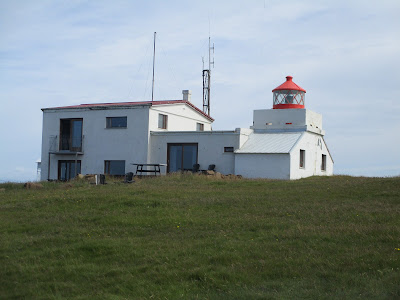The next morning, we had reservations at 10am on the car ferry to the Westman Island of Heimaey. This is an island group off the south coast of Iceland. The Westman Islands are famous for their sharp cliffs and extensive bird nesting populations. We had our BnB reserved for two nights at a working farm near the ferry dock, so we left our belongings at The Little Green Cabin.
We took a few pictures of the livestock on the way out in the morning. These "My Little Pony" horses are breed in Iceland and are commonly seen on farms and ranches throughout the country.
This sweet cow was interested in us as she stands pictured next to the lupine.
Soon her friends came to join.
We drove our Mazda 2 into the hold of this ship for our 40-minute boat ride to the island.
There are 14 islands in this bird watcher's paradise.
Heimaey is the only inhabited island in the archipelago. The narrow harbor entrance is located in the town of Vestmannaeyjar.
HERJOLFSDALUR
An extinct, collapsed, volcanic crater forms a natural amphitheater for concerts and festivals.
Stairs are available for those who wish to hike the rim.
This is reproduction of a 9th to 10th century Viking long house.
The back of the house was for livestock and the family lived in the front.
Eurasian Oyster Catcher
PUFFIN LOOKOUT
Over 60 percent of the world's population of Atlantic Puffins nest in Iceland.
Lighthouse at the south end of the island.
Sheep help keep the grass mowed. They were panting on this warm 60-degree day.
The sheep rub on the fence posts to help shed their winter coat.
Numerous puffins could be seen through our binoculars nesting from this bird blind near the lighthouse.
Pirates Cove where the ocean has nearly separated the island in two.
This crescent shaped bay is where in 1627 Algerian pirate boats landed and captured most of the islanders for the slave trade.
A cruise ship was anchored within the narrow mouth of the harbor. It is barely wide enough for a large ship to pass. The depth was increased and is maintained with a powerful dredging barge.
STAFKIRKJAN OR STAVE CHURCH
This Stave Church was gifted to Iceland by Norway. It was built in 2000 to commemorate the 1,000th anniversary of Iceland’s conversion to Christianity. The state religion of both countries is Lutheran. The Stave Church stands on the grassy area by the harbor. It is a replica of the first church in Vestmannaeyjar.


Simple Altar
A double wall construction surrounding the exterior walls was used to help control the inside temperature.
Remnants of the city's water tank which felt the fury of Eldfell in 1973.
Half of the town was destroyed by the 1973 eruption. From this hill, we could see the point at which the lava flow stopped.
ELDHEIMAR VOLCANO MUSEUM
In the middle of the night of January 21, 1973, a volcanic eruption started along a fissure just above the town of Vestmannaeyjar. Most of the residents were evacuated. The eruption lasted six months, destroying a third of the town. Lava from the newly formed Eldfell Volcano expanded the island by 20 percent. Islanders were afraid that the already narrow, protected harbor would be sealed by the lava, so sea water was sprayed on the hot lava 24 hours a day to try to stem its flow. Because of the high cliffs surrounding the island, if their attempt was not successful the island, without a harbor, would have become a ghost town.
This museum tells the story of the 1973 Eldfell eruption which destroyed over 400 homes.
The museum was built around an actual house that had been buried in 20 feet of ash.
Many of the houses are still under ash.
After having dinner at Tanginn Restaurant, which featured horse steak and Minke whale on the menu, we boarded the 7pm ferry for our 40-minute return to the mainland. We were glad we had ferried our car across with us because it allowed us to explore the entire island using the 17 miles of existing roads. We helped a hitchhiking U.S. family who did not bring their car and were exhausted from walking. I think we were over the weight limit after the family of four somehow crammed into our backseat.
We sat at the stern watching the islands fade away in the setting sun.








.jpg)



.jpg)























































